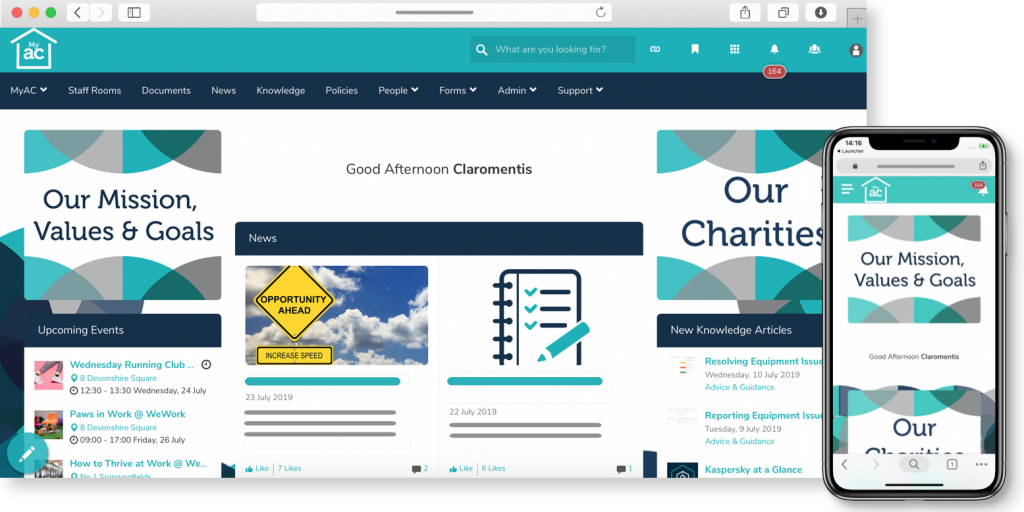An intranet, or digital workplace, can do so much more than organise your school’s employees, data, and documents. The true benefit of the intranet in educational establishments is its ability to provide a service which staff enjoy using, because it enhances their day-to-day life and energises the workplace. When used in the best way, an intranet’s benefits are truly endless.
Working in an educational environment creates its own unique challenges, so having an easy-to-use communication system at your fingertips is paramount. Schools and higher education establishments need to move away from viewing the intranet merely as a way of distributing information from the hierarchy down to the employees. Instead, for a school intranet to become really effective, it must become a knowledge-sharing forum to which everyone can contribute.
Intranets are particularly useful to educational establishments that are geographically dispersed, such as sites at different campuses that share common educational objectives and communication needs. Schools are also particularly concerned about the security and privacy of their information since it includes children’s personal details. Again, digital technology can address these concerns.
Viewing and updating files and documents
Whether you’re designing a university brochure, updating an employee handbook, or preparing applications for grants and other financial aid, the intranet will enable users to update and view the documents with ease. Teaching and administration staff will deal with many tasks on a day-to-day basis which can be managed effectively via the intranet, such as preparing projects, managing the classroom curriculum, and scheduling meetings, activities, and special events.
The whole workforce can be kept up-to-date with all aspects of these tasks and will be able to communicate with fellow staff easily – even those at other sites – so that everyone feels involved.
Keeping accurate staff records
Every employee, whether they’re teachers, administration staff, or part-time workers who run after-school clubs, for example, can have their details stored on the intranet, with a photograph if required, so that employees at different campuses, who may seldom meet, can put a face to the name.
This is particularly valuable for universities, who may have hundreds of teaching staff and thousands of students. Heads of departments will have access to information about their teaching staff at their fingertips, enabling them to choose the right people for a specific project or initiative, without concerns about collating information from various campuses.
Sharing information with colleagues
Every member of staff will have the ability to upload and share information with colleagues whenever they choose, from the dean or head teacher down to part-time and supply teachers. Employees will be able to share information about projects on which they are currently working, encouraging feedback and dialogue. It’s not a case of the head passing on information to the staff, but rather every employee, no matter what their role, playing an active part in the efficient running of the university or school.
Helping students with coursework
Good communication is the foundation for running an efficient educational establishment. In addition to facilitating collaboration among staff, the intranet can help students with their coursework, providing a central point where they can contact tutors and their peers with ease, at any time of the day, even after-hours, should they have a problem.
A university has multiple levels, with groups of people working together on particular projects, perhaps from different departments, with different schedules. The intranet makes it easy for these people to communicate in a central place, whatever their schedule, even if they’re working at different times and locations.
Personalising children’s learning
Teachers already using an intranet say personalising pupils’ learning is the key to success – and in particular, making the students responsible for personalising their own learning. It’s all about utilising a system that has everyone involved. In the past, the intranet was used primarily as a place to store documents and digital resources for teaching. Today, the intranet is being used for more than simple file storage.
Pupils are set tasks online and are responsible for sending them in to meet a deadline. Work can be marked very quickly and returned to the students. With some systems, parents or guardians can also access the intranet, so that if there’s a problem, they can contact the teacher quickly to see what steps can be taken to alleviate any concerns.
The “parent reporting” and “use anywhere” technology means those students and pupils who have access to the intranet can use it through a secure gateway, even from home. The key is ease of use – easy for teaching staff to upload information, and easy for students to access and use the content.
More advanced intranet systems allow students to join discussion groups, take simple quizzes and tests, and access live information. The most important benefit of an intranet platform is that it enables students to stay in constant touch with teachers, their schoolwork, and their classmates. Having an efficient virtual learning environment is vital to underpin the work that takes place in the classroom.



